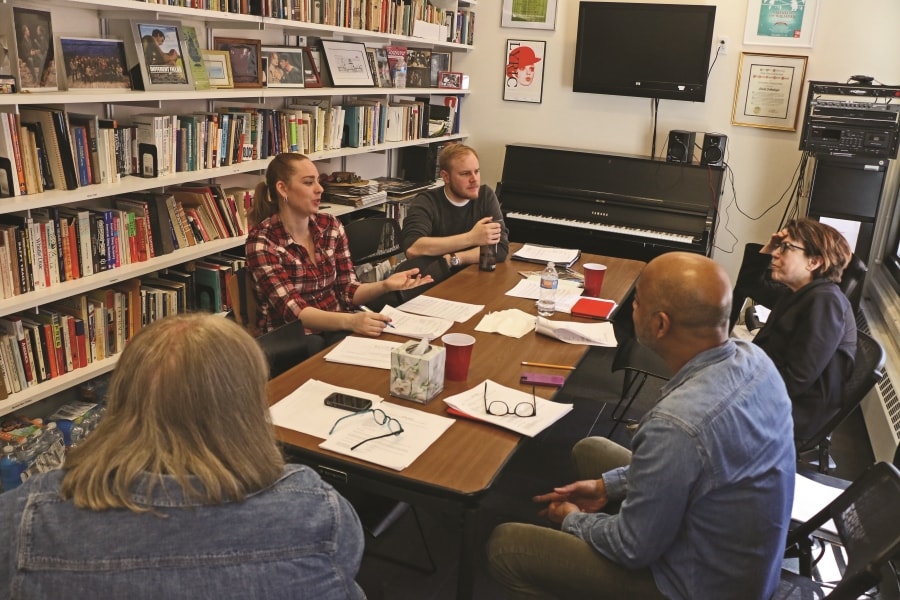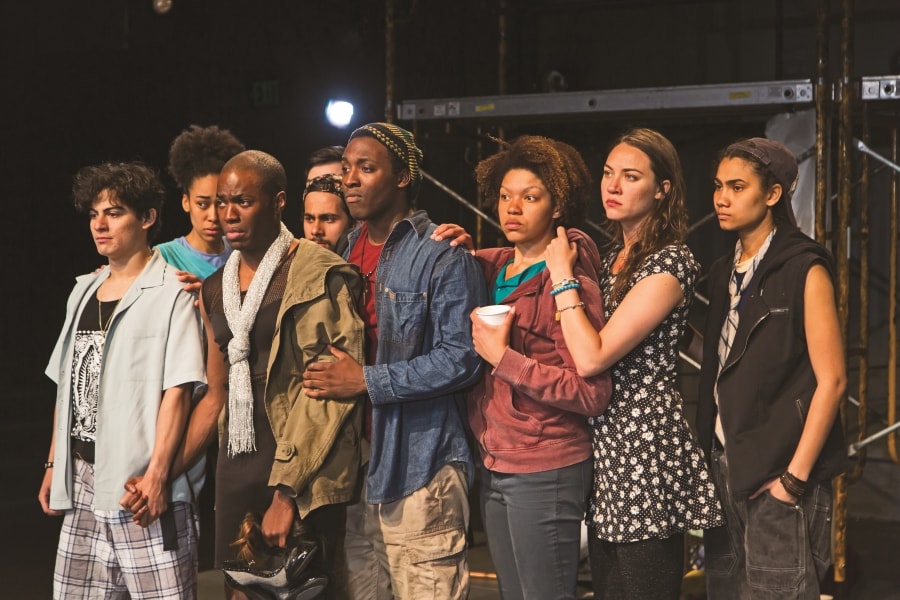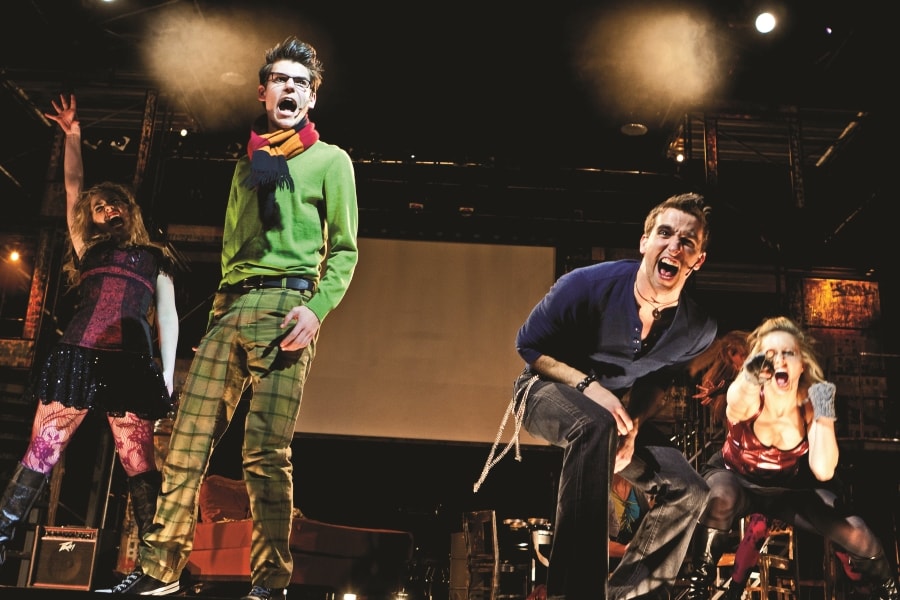The first graduate from one of the oldest musical theatre programs in the country hopped on a Greyhound bus, her tap shoes in her suitcase, and traveled to New York City. Soon after, she made her Broadway debut in a little-known musical by a composer she hadn’t heard of and earned a Tony nomination for her performance in 1971.
Though Pamela Myers’s Cinderella-like journey from a student at Cincinnati College-Conservatory of Music’s (CCM) musical theatre program to the role of Marta in the Stephen Sondheim show Company is every musical theatre kid’s dream, it is not something the program’s current chairman, Aubrey Berg, encourages for his students anymore. “I think for anybody to do that nowadays is pretty much impossible,” says Berg. “You can’t just arrive at the Port Authority with your suitcase and hope to be discovered.”
Instead of encouraging students to follow this old script, programs are now aiming to prepare students for the current market, in which actors increasingly write their own shows, classically trained singers must master hip-hop dance breaks, and dancers are expected to act. From performance to playwriting, it is the interdisciplinary artist that is now the goal of educators. While CCM had Myers’s career to hang its hat on when Berg arrived there more than 30 years ago, he began to notice that students needed further training in acting and dance beyond just voice. He now says that the program is known for its “triple-threat training.”
But even the old singing/dancing/acting triumvirate has expanded, as programs such as Pace University of NYC’s musical theatre program are now training their actors to follow the hyphenated lead of Lin-Manuel Miranda and Dave Malloy. And at some playwriting programs, students are being taught to follow the footsteps of writers like Marsha Norman and Sybille Pearson in crafting books for musicals as well as plays. Meanwhile some music conservatories are finding ways for vocal performance majors to expand their skill sets. After all, look at the path of two classically trained singers, Kelli O’Hara and Kristin Chenoweth.

David Gomez was attracted to Pace University’s program because of the freedom it allows students to create their own work. Gomez wrote a musical in high school and hoped to continue on that track on top of his performance coursework at Pace. Not long after arriving at Pace, he found other performance majors with the same writing habit.
“It felt like a dirty secret,” Gomez says. “We would meet in practice rooms and share our songs. Some people were just songwriters, and we eventually formed this collective need to share stories and songs.”
His music theory teacher, Ryan Scott Oliver, recognized the impulse: He also performs as well as writes. So the composer/lyricist crafted a two-part fundamentals in musical theatre writing course for those students. “It helps them understand what it means, how a piece is constructed,” Oliver says. “All that can guide them as actors once they understand what the writer is dealing with, once they understand what their process is.”
Gomez was a sophomore when the class began with 12 students in the first semester, and he wrote for his performing peers, including for a freshman showcase called “Hatched.” While Gomez remained a performance-based musical theatre major, he entered New York University’s graduate musical theatre writing program immediately after graduating from Pace in 2014 and completed an MFA in musical theatre writing in May 2016.
“I was fortunate to be in two programs that were very eager to grow and have changed a lot,” Gomez says. “Being in a program that doesn’t have a musical theatre [writing] program when you arrive and then does when you leave, then there’s almost this legacy of that.”
The interest is only growing. Pace’s course, currently in its fifth year, grew to 30 students during the fall 2016 semester. “That really speaks to the interest of the students in what we do and how we develop work,” Oliver adds.
While the course has inspired students such as Gomez to shift their career paths to writing, other students have combined their performance career with their writing. Like Gomez, Kailey Marshall was a musical theatre major when she enrolled in Oliver’s course, and her writing became an integral component of her performance career. She wrote her song cycle Songs for Slutty Girls, in which she also stars, while she was at Pace, and since graduating in 2015, she has continued to revise the show and hopes to produce it again.
“It’s teaching musical theatre kids that you as a performer, and you as a person, can do so much more than just that,” says Marshall. “I would have never known that I wanted to write for musical theatre unless I’d gone to Pace.”
Performers are putting pen to paper at training grounds beyond the traditional college theatre setting. During the National Music Theater Institute semester at the Eugene O’Neill Theater Center in Waterford, Conn.—added to the National Theater Institute three years ago—students participate in every aspect of the theatre process, including writing.
NMTI makes up one term of NTI’s six-semester program, which allows students with a minimum of a high-school diploma or GED to receive training. Students who complete the program can earn college credits, which are honored at Connecticut College. While some students use the institute as a gap year between high school and college, others jump straight into their professional career after completing the program.
By the end of the 14-week NMTI semester, students will each have written a one-act musical. NMTI’s 46 students put on four one-acts a day during Playwrights and Librettists Week, and many of the students choose to produce a musical during that week. During the week, students form a repertory company, rotating their creative positions (producer, director, costume designer, etc.) every six hours to produce four new one-acts a day. The one-acts are written by every NMTI student throughout the semester and are overseen by guest mentors.
“We don’t want them waiting for the phone to ring,” says NTI artistic director Rachel Jett, who holds an MFA from NYU’s graduate musical theatre writing program. “We want them to make work if they want to; that’s why we encourage that.”

Although Sybille Pearson began her career writing plays, she was asked to write the libretto for Baby, which would open on Broadway in 1983. That first crack at writing a musical turned out to be a success and earned her a Tony nomination, catalyzing the crossover from playwright to book writer. “I don’t think my journey is that unusual,” Pearson says.
Indeed the lines between playwright and book writer are now blurred, both on Broadway and in the classroom. Pearson joined the faculty of NYU’s graduate musical theatre writing program shortly after gaining acclaim for Baby, and she still teaches there.
“I don’t often work with already established book writers,” Pearson says. “Mainly the group that musical theatre book writers come from are playwrights.” Even in strict playwriting courses that focus on creating non-musical works, Pearson lets book writing leak in. “Just to stay solely in playwriting is not terribly helpful in the end, because you really have to start understanding the differences,” she says.
Pearson’s NYU colleague Donna Di Novelli has also taught at NMTI (previously serving as a guest mentor during Playwrights and Librettists Week), and she too has seen an interest surge in playwrights aspiring to be musical book writers. “It goes back to Aristotle, right?” Di Novelli says. “Aristotle had music as one of his components of drama.”
Although the Yale playwriting MFA is within the Yale School of Drama, quite apart from Yale’s undergraduate Shen Curriculum for Musical Theater, established in 2006, MFA playwriting students there are required to take the curriculum’s courses in lyric and book writing.
“It is important for writers who are interested in a career as professional writers, professional playwrights writing for other media, that they be aware of, trained in, and understand the importance of musical theatre as an art form,” says Jennifer Kiger, a lecturer in the playwriting program.
Many graduates of the Yale School of Drama have accordingly crossed disciplines during the course of their career. While Roberto Aguirre-Sacasa wrote the book for Broadway’s American Psycho, he is also the executive producer of the upcoming TV show “Riverdale,” which premieres on the CW this year, and he’s the author of such plays as Abigail/1702.
Kiger is also the associate artistic director of Yale Repertory Theatre and the director of new play programs at Yale’s Binger Center for New Theatre, where she oversees commissions as well as new-play development. Kiger says she’s noticed an increased interest among playwrights who either want to write a musical or otherwise incorporate music into their new work. “Perhaps people don’t want to be put in a box,” she suggests. “If you’re a theatre artist, you’re a creative artist. You want to be able to create work and do it in lots of different ways.”
Is this indicative of a larger trend of playwrights wanting to venture into musical theatre, or are there simply more resources dedicated to the development of musicals and musical theatre education programs now? “I’m not sure that all of a sudden people want to make music theatre,” Kiger says. “Maybe there’s just more of a sense of how important it is to offer resources and training for people so that the next generation of artists can come along and put their stamp on it.”

Two of Oklahoma City University’s most famous alums, Kelli O’Hara and Kristin Chenoweth, hold vocal performance degrees from the school. Since the pair graduated, the program, which offers a bachelor of music in music theatre, has put an emphasis on the triple threat and even added a New York City showcase, allowing seniors to perform in front of agents before they venture into the business.
“We know we have to prepare our students to be nimble and adapt to whatever the current market is,” says David Herendeen, the director of the opera and music theatre program at OCU and a former professor of O’Hara’s. “Kelli is a really good example of somebody that paid attention to the industry and what it was demanding.”
Meanwhile back at the Cincinnati College-Conservatory of Music, the venerable musical theatre program is adapting to the new world as well. Established within a music conservatory by Helen Laird in 1968, it began by preparing students for careers in musical theatre primarily by offering them classical vocal training, but Laird “was noticing that the kids needed a lot more than just a great voice,” as program director Aubrey Berg puts it. Hence the decision to establish a musical theatre program within the conservatory.
When Berg took over the leadership of the program, though, it still lacked training in dance and acting. “The big word that we use here is ‘integration,’” Berg says. “We like them to be able to move very fluidly from one mode of expression to another. I always say that if I had a T-shirt it would say: ‘Sing while you act, act while you sing, dance when your character needs to.’”
One of the first changes Berg made was to create a more rigorous acting curriculum and extend acting courses to a four-year cycle of classes. “I think the basis of good musical theatre performers is that it comes from the acting,” Berg says. “It’s the glue that holds all the elements together.”
In addition to more extensive acting courses, Berg added training in the practicalities of the business, including audition techniques and, as Berg phrases it, the “business side of show business.” In short, the days of the wide-eyed graduate arriving in New York with just tap shoes and a suitcase are no longer.
“When they move to New York you want them to have their childlike sense of creativity and bliss, but you also want them to go with their eyes wide open because it’s a very, very tough profession,” Berg says.
Meanwhile in Berea, Ohio, another school has adapted to the changing marketplace, though in a slightly different way. At Baldwin Wallace University’s Conservatory of Music, musical theatre students take an additional year of music theory and piano and graduate with a bachelor of music in musical theatre rather than a bachelor of fine arts, since the latter degree doesn’t exist at the conservatory. The program has morphed in other ways: Seven years ago, it beefed up the dance curriculum, scheduling additional dance classes and making all dance classes longer. Students now participate in “ballet boot camp,” which consists of 7 a.m. ballet classes four days a week. Still, the central emphasis is on the “musical” part of musical theatre. As program director Victoria Bussert puts it, “Our students have advanced musical training that has served them very well in making their careers.”
While each musical theatre program has a different approach, all agree on one thing: The fact that musical theatre is changing is not really a change at all.
“We can’t help but be sensitive to it because we’re neck deep in it,” NYU’s Bernstein says. “As opposed to academics who might have once been involved but are no longer, or are far afield from New York City, the sort of epicenter of what’s going on. Because the form is so rapidly shifting, it seems to me, you can be out of touch if you’re not careful.”
The process has a built-in feedback loop: After the professors contribute to the current landscape of theatre, they go back and bring their knowledge and experience to the classroom. And their students go on to create new work, driving shifts in the landscape and adding to the current canon, requiring their professors to go back and redraft their curriculum once more.
“The greater your skill set, the more employable you are,” says Berg. Even more important, he adds, “the more interesting the works are.”
Maggie Gilroy, a former intern of this magazine, is a news reporter for The Press & Sun-Bulletin in Binghamton, N.Y.


